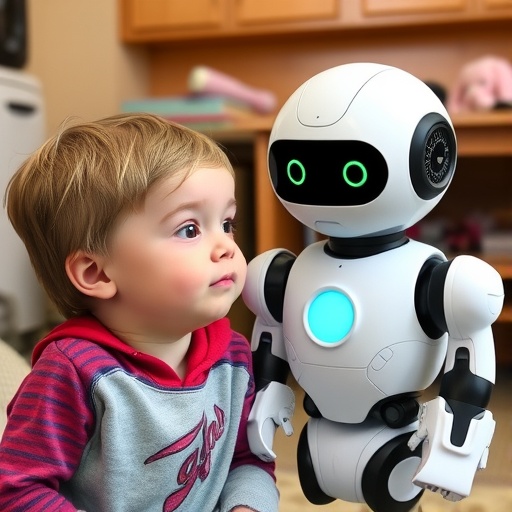What becomes of a social robot after it retires? This question guided a unique longitudinal study centered around Luka, a small owl-shaped reading robot introduced into the homes of 20 families, each with preschool-aged children. Designed to foster early literacy by scanning picture books and reading aloud, Luka’s original function seemed straightforward. However, as time progressed and the children aged beyond the robot’s intended reading level, researchers anticipated Luka’s usefulness—and presence—to fade away. What emerged was a profound insight into the evolving relationship between humans and social robotics, one far richer than simple utility.
Luka was deployed in 2021 to serve as an interactive reading companion, supporting children at a critical developmental stage by blending technology with education. This intersection of Human-Robot Interaction (HRI) and child development uniquely positioned Luka as both a tool and a companion. By mid-2025, researchers revisited these families expecting the robots to have been abandoned or discarded, their technological novelty worn thin. Instead, Luka had transcended its early purpose, lingering in most households well beyond its designed lifespan.
The observational study revealed that 18 of 19 families retained Luka, with many continuing to charge it despite no longer actively using it as a reading aid. Some repurposed the robot into music players or gentle night lights; others simply displayed Luka on shelves and bedside tables, where its softly glowing eyes seemed to symbolize a cherished family artifact. This enduring presence illustrated a transformation from functional device to treasured keepsake, signaling a fundamental shift in how families integrate technology into their daily lives.
Central to this evolution was an emotional attachment that superseded mere utility. Children referred to Luka with personal affection—some calling the robot “my little brother,” others reflecting that Luka was their “only pet.” Parents, too, expressed a form of nostalgia, admitting they valued Luka as a sentimental token of their children’s early formative years and the bedtime rituals the robot had helped cement. This emotional layering suggests that social robots can embed themselves deeply within the fabric of family life, becoming symbolic participants rather than just programmable gadgets.
Though Luka’s interactivity was limited—it neither roamed autonomously nor engaged in complex conversations—the robot nonetheless became woven into a family’s symbolic ecosystem, much like a beloved stuffed animal or a treasured childhood drawing. This finding carries significant implications for the field of Human-Computer Interaction (HCI) and HRI, which often concentrates on immediate engagement metrics and the novelty factor. Instead, this study illuminates how emotional bonds and meaningful usage evolve over years, demanding a longer view when designing and evaluating social robots.
Moreover, the physical placement and personalization of Luka within homes underscored its transformed role. Far from being stored away when obsolete, Luka frequently occupied prominent spaces such as desks or bookshelves. Some families adorned it with doilies, while others attached hand-drawn name tags, personalizing the robot as though it were a keeper of family memories. This act of displaying technological artifacts crosses into the realm of ritual and identity, underscoring the robot’s shift from a utilitarian object to a symbol of childhood and family.
For designers and researchers, these findings urge a reconsideration of a robot’s lifecycle. A robot’s usefulness does not end abruptly when its functional role declines; instead, it often transitions into a companion or keepsake that carries emotional significance. Anticipating this transition can encourage the creation of social robots with adaptable roles, enabling them to evolve alongside their human users rather than be discarded once their primary task concludes.
The children’s reinterpretations of Luka after retirement were particularly striking. Rather than discarding the robot, some began “teaching” Luka new stories, or inventing bedtime narratives for it, treating the device more like a family member than a machine. Others used Luka to soothe siblings, extending its social role within the household. These behaviors highlight a dynamic interactive relationship, where users not only consume the robot’s input but actively contribute to its social presence, redefining the traditional boundaries of human-robot interaction.
Further insights emerged when families conducted “retirement ceremonies” for Luka, wherein one child passed the robot to a younger relative, symbolically acknowledging the end of its primary function but sustaining its presence within familial memory. This ritualized transition emphasizes the need for graceful “goodbye” protocols in the design of social robots, recognizing that emotional attachments necessitate thoughtful closure rather than abrupt disconnection.
This study also invites reflection on the broader societal implications of increasingly integrating AI-powered companions into domestic spaces. As children form lasting attachments to such technologies, researchers and designers must prioritize long-term engagement and emotional continuity over the short-lived excitement of novelty. Understanding how robots are remembered—and how they remain part of family narratives after active use ends—can lead to more meaningful and ethically considerate designs.
Finally, the case of Luka underscores a paradigm shift in how technology is embedded within human life. Social robots are not merely functional tools that are used and discarded; they become layers in a family’s emotional and cultural landscape. For the future of AI companionship, this means designing robots that accommodate a life beyond immediate utility, fostering long-term relationships that are as much about memory and identity as about functionality.
As the presence of social robots like Luka grows in homes worldwide, this study reminds us that their true value may lie not only in what they do, but in how they stay. Their silent companionship, symbolic presence, and eventual ritualized farewell all reveal a nuanced narrative of evolving human-robot relationships—one that future research and design must embrace to truly resonate within human lives.
Subject of Research: People
Article Title: The Robot That Stayed: Understanding How Children and Families Engage with a Retired Social Robot
News Publication Date: 8-Aug-2025
Web References: http://dx.doi.org/10.3389/frobt.2025.1628089
Image Credits: Dr Zhao Zhao, University of Guelph
Keywords: social robot, Human-Robot Interaction, emotional attachment, child development, technology lifecycle, AI companions, longevity, family technology, robot retirement, human-computer interaction




